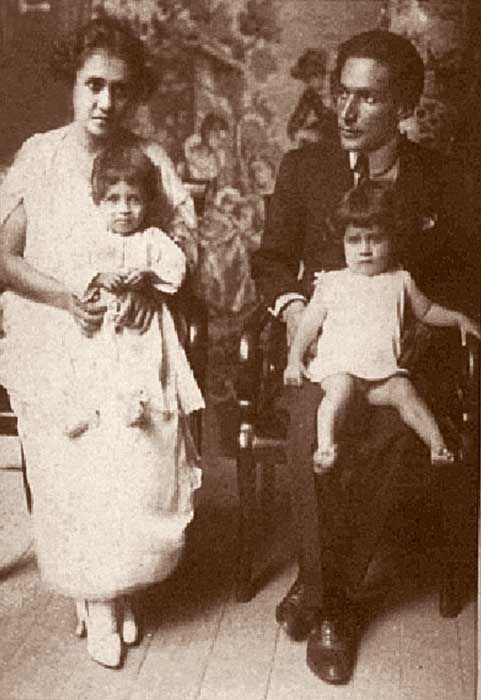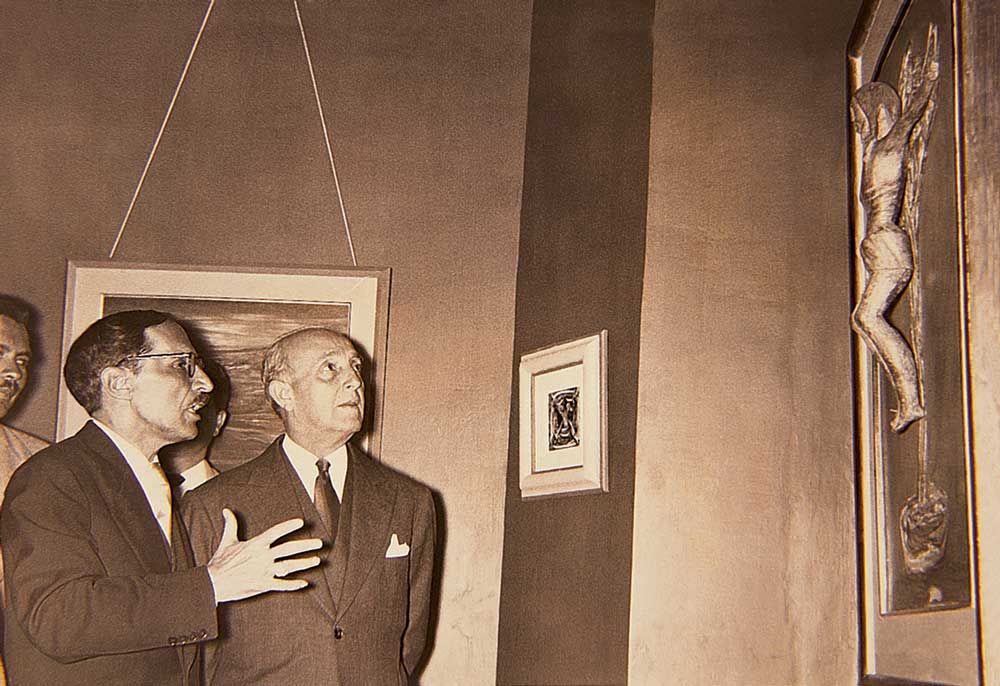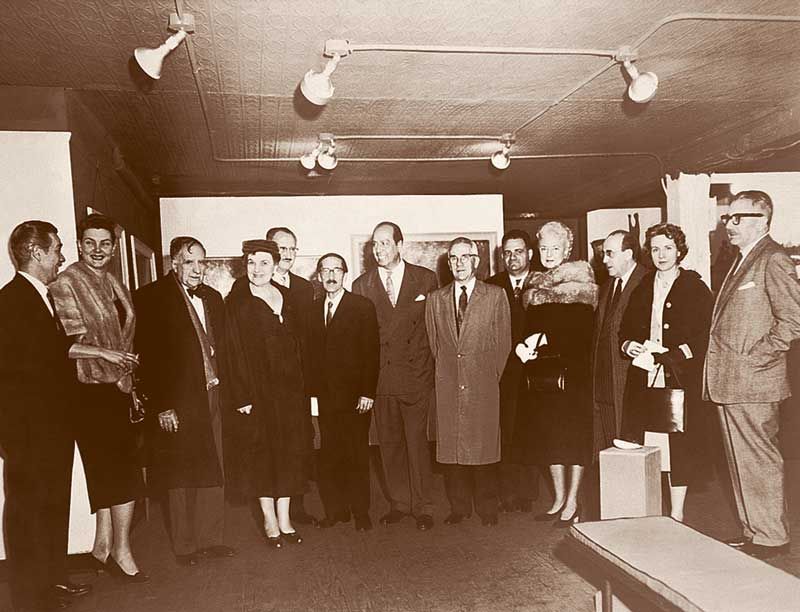
Adriana Romero de De la Torre, Macedonio de la Torre and his children Zoilita and Gustavo.
Macedonio returned to Lima with his family in 1930. He was already father to three children, and was ready to live in Lima on a permanent basis. In the following months, specifically August of this year, the government of President Augusto Leguia fell and the country was submerged in a grave economic crisis. Later, in 1932, the Aprista Revolution would break out, resulting in the imprisonment and persecution of this Party’s members, including founder Víctor Haya de la Torre and his brother Agustín. Shortly after his return, Macedonio held his first individual exhibition in the capital at the Academia Alzedo, surprising visitors with the plastic audacity of his works, which reflected his European vanguard experiences. This effect was even greater if one considers that “indigenism” was prevalent in the current context, based upon a tendency or “school” led by indigenism´s mentor and principal plastic representative, Master José Sabogal, from Cajabamba. This individual had driven the push towards a figurativism that rescued and appreciated the value of man and the Peruvian landscape with special emphasis on the Andean universe. Macedonio´s exhibition was an expression of very personal plastic tendencies that demonstrated the formal conquests of cubism and the initial awakenings of abstractionism. He opened the doors of Peru to modern plastic arts in the same way that Ricardo Grau had expansively renewed the Peruvian art world with his pictorial proposals upon his return to Peru from France. Grau held a notable exposition at the “Brandes” gallery in 1937. In this line of renovators of Peruvian plastic arts, we must remember Fernado de Szyszlo. He arrived after the aforementioned individuals in 1951, also after a stay in Paris, exhibiting works that reflected abstractionist tendencies. Szyszlo, like Macedonio and Grau, elicited reactions and controversy. Three decades of continuous production and the criteria and contributions of these artists produced powerful contemporary currents in the national world of plastic arts. All of these individuals drew upon their experiences with cutting edge advances in Europe, and particularly in Paris, during the second half of the fourth decade of the XXth century.

Adriana Romero de De la Torre, Macedonio de la Torre and his children Zoilita and Gustavo.
The President of the Republic Manuel Prado Ugarteche with Macedonio de la Torre at an exposition of his work in Lima.

Juan Manuel Ugarte Eléspuru described Macedonio´s first exhibition in Lima in the following way: “ There were city scenes of locations on the Old Continent, and some rural scenes were also included. There are some portraits, although the human figure was never one of his preferences or primary goals. The treatment of these primitive paintings naturally reflects, in general terms, the important characteristics of the European plastic arts between wars: the School of Paris and moreover the influences of synthetic cubism with Cezanneseque and German expressionistic reminiscences. It was a mosaic of theories and tendencies in the amalgamated processes of assimilated experiences. This vanguard pictorial exhibition was a first in Lima, given that it involved all types of innovations: latent cubism in its stylizations and its synthesis of urban images seen from close-up; “fierism” (fauvism) in the style of the fauvist Parisians with their shrill colors and audacious vision. Something of Picasso is present in the landscape painting of Horta de Ebro, and Cezanne´s influence is also visible in the scenes of France at mid-day. Some contortions of expressionism are also present. These were most certainly destined to commemorate his contacts with members of the “Die Brüke” and “Der Blau Reiter” groups in Münich. There are also some early essays of abstractionism in the style of Kadinsky and reflecting the expressionism of Nolde.”
The 1930´s was full of drama for the painter given that his family was deeply affected by the political commotion arising from the imprisonment of Haya de la Torre and the consequences of the bloody events in Trujillo that ended in deaths by firing squad and persecutions. Macedonio suffered the loss of two of his young children: Alberto in 1933 at the age of seven, consequence of the accident that had left him paralyzed a few months after his birth in Brussels; and Zoilita, who died in 1936 of Scarlet Fever. After these losses, his offspring were reduced to two boys who would carry on the family line: Gustavo, born in Trujillo in 1922, and Víctor, born at La Punta two years after Macedonio´s arrival in Peru in 1932.
Macedonio painted incessantly from the moment he returned to the capital until his death in 1981. His atelier from the 1950’s on was on the seventh floor of the “California” building located on Mogollón street- on the second block of Moquequa street- in the center of old Lima; it was here that the artist would hold his meetings. This atelier consisted in two rooms and a bathroom; its chairs and seats were covered with paintings, and pots with plants and paint tubes were scattered throughout. His old oil paintings hung on the wall next to Christ images made from shrubs or bones and pieces that he had recently finished. An album with cuttings from rag newspapers, which Macedonio showed off with infantile joy, were evidence of commentaries made about him during his long pictorial career. Macedonio rarely left the city that would come to consider him one of its characteristic and, in time, traditional personalities.
Following a quarter of a century of absence, our painter returned to his birthplace in 1954 to receive the Silver Medal and Diploma of Honor from the Provincial Council of Trujillo. He would return to Trujillo in 1961, this time to attend an exhibition-sale of his art that was organized by the “Libertad” club. The only trip he made abroad during these years was in 1959 to New York, where he would reside for several months and exhibit at the South American Gallery directed by Armando Zegri in Greenwich Village and at the International Gallery. Macedonio received favorable reviews of his work in the American Press. Macedonio was impressed by the Big Apple” and its luminous skyscrapers and scenarios, sometimes desolate, perhaps even empty, or full of miniscule dancers that seemed to become lost under the extremely high scaffoldings that were hidden behind frames.
Exhibition of Macedonio de la Torre’s works in New York. You can see Víctor Andrés Belaúnde in the photo.

His life in Lima and his exposure to its poor neighborhoods are reflected in a tendency evident throughout his work- depictions of the modest abodes of Andean migrants that were superimposed on the neighboring hills. These homes are colorful, and the crude reality surrounding them is not evident; this dramatic topic also served as a pretext to compose volumes full of color that enter the imaginary world through their plastic power despite the abovementioned origin.
Another of Macedonio´s favorites was landscape painting. Some of these works constitute veritable plastic triumphs that elicit profound emotions due to the depth Macedonio created on the canvasses and his creation of a melancholic and captivating atmosphere. Macedonio´s dedication to this plastic line sprang from his years of training and his European experience. In his work in this genre, he utilized various methods: beginning with those that demonstrated his close observation of the Dutch masters, specifically the Nordics who practiced this genre in the XVIIth and XVIIIth centuries, the romantics such as Eugene Delacroix, and those conceived by the impressionists and French and Italian pointalists. These landscape scenes of coastal sandy areas are praised for the magic they contain.